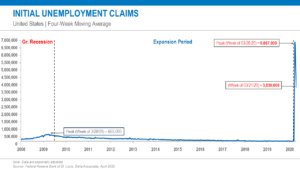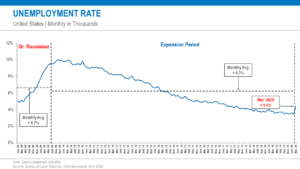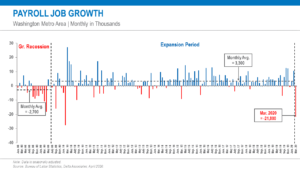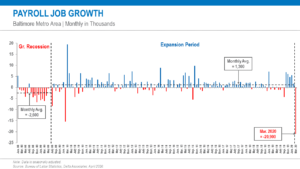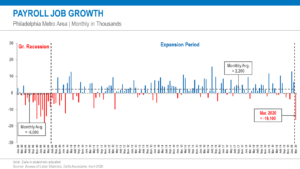The Early Impact of COVID-19 on Regional Labor Markets
Now that March employment data for metro areas have been released by the Bureau of Labor Statistics, we can take an initial look at the early effects of the COVID-19 pandemic on regional labor markets in addition to the larger national labor market. Below, you can find charts and brief summaries of the employment situation for the National, Washington metro, Baltimore metro, and Philadelphia metro economies.
National Economy
The COVID-19 pandemic caused by the novel coronavirus has produced severe disruption to the world economy, including in the U.S. in the first quarter of 2020. Prior to the pandemic, most domestic economic indicators were healthy, including employment. Both January and February experienced the greatest monthly growth in nearly two years—214,000 and 275,000 respectively. However, job growth has since taken a swift and severe beating due to the pandemic. National net job growth (seasonally adjusted) for the month of March 2020 was -701,000—the biggest monthly job loss since March 2009. In addition, the net employment loss in April is poised to set an all-time record.
Since the number of national unemployment claims is updated weekly, it has provided a more up-to-date picture of shifts in the labor market. Unemployment claims sky-rocketed almost immediately after stay-at-home orders began to be implemented and non-essential businesses were shut down across the nation. The four-week moving average of unemployment claims hit a record high of 6,867,000 the week of March 28, nearly 10 times higher than the Great Recession peak of 665,000.
The national unemployment rate was at a 50-year low of 3.5% in February 2020, but unsurprisingly spiked 90 basis points to 4.4% in March, 60 basis points higher than a year prior. By the April jobs report next week, unemployment will likely crest the 5% “full employment” mark and continue rising though the year and into 2021. The “good news” is that the timing of the pandemic was ideal in that unemployment was at such a remarkably low level, so there’s a lot more runway before the economy hits severe levels of unemployment, compared to a pandemic in the midst of a recession (such as at the time of the “Swine Flu” pandemic).
Washington Economy
The Washington metro area’s economy had been on a hot streak, capped by three straight years of rising job growth. However, that streak has come to a swift and sudden end in the first quarter, as the COVID-19 pandemic wreaks havoc on the local economy. Most business in the Washington metro area came to a virtual standstill in March as restrictions forced most businesses to temporarily close or limit service. Numbers recorded right before the pandemic arrived show robust job growth and low unemployment across the region. Over the 12-month period ending February 2020, the metro area added 55,600 new jobs. Seasonally-adjusted job growth in January and February was 3,400 and 10,500 respectively. Gains in both months were completely erased in March, when job growth plummeted to -21,800.
The near-term outlook for the Washington metro economy is grim. However, the metro area’s high concentration of Federal workers will likely help it weather the impending recession better than other regions, but it will encounter stiff headwinds in the period ahead.
Baltimore Economy
The Baltimore region had also seen renewed job growth up until the pandemic. During the 12 months ending February 2020, the region added 11,400 new jobs, 2,500 more than the long-term average of 9,700 new jobs a year. While job growth for much of 2019 was lackluster or even negative, there was a strong bounce in job creation late in the year into 2020. Between October 2019 and February 2020, average monthly job growth (seasonally-adjusted) was an incredibly strong 5,000 positions. Unfortunately, that streak came to an end in March when job growth fell to a jaw-dropping -20,900, a loss nearly equivalent to that of the much larger Washington metro area.
The Baltimore region’s strong dependence on the Federal and Education/Health sectors will help it to endure the recession, but its economy is more exposed than its neighbor to the south.
Philadelphia Economy
Prior to the pandemic, the Philadelphia metro economy was also chugging along relatively smoothly. Job growth overall was relatively robust, with 29,200 new positions added during the 12 months ending February 2020. Seasonally-adjusted job growth in the first two months of 2020 was especially strong, with 13,000 net additions in January and 6,600 net additions in February. Unfortunately, job growth for the year is almost in the red as of March, when employment fell by 16,100 positions.
The Philadelphia metro area’s relatively high concentration of Education/Health Services employment will ease some of the struggles in the period ahead.


